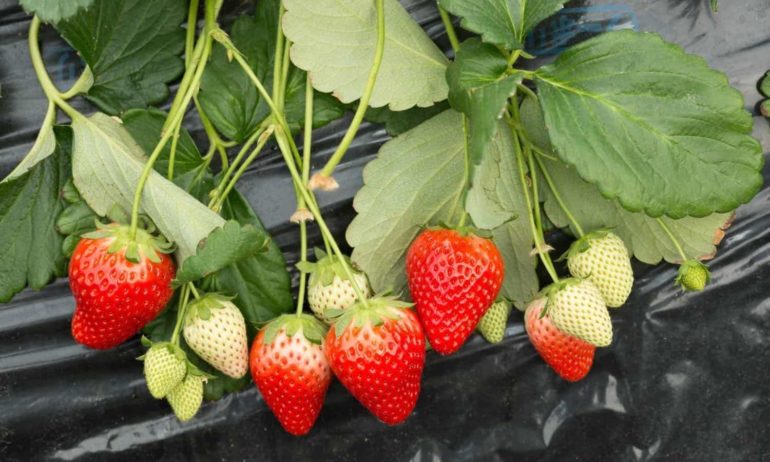As the dramatic consequences of industrial development continue to worsen—from the five thousand mile dead zone in the Gulf of Mexico to Antarctica’s depleted ozone layer hole the size of North America—it is incumbent upon all industries to do their part to find solutions to global problems. Eliminating the use of the ozone-depleting chemical, methyl bromide, is one achievable solution that the U.S. government has forestalled for far too long. Surprisingly, strawberry fields account for nearly all of the methyl bromide used in the U.S. Injected as a fumigant in the soils of nursery transplants and again in strawberry fruit fields before planting, methyl bromide “sterilize[s] the soil, killing the vast majority of soil organisms.” Although farmers cover fumigated fields with plastic tarps, 50-95 percent of the chemical escapes into the atmosphere by the time they’re removed.
When released into the atmosphere, methyl bromide contributes to the thinning of the ozone layer that protects all life on Earth from the sun’s harmful ultraviolet (UV-B) rays. That’s why nearly 200 signatories to the United Nation’s Montreal Protocol agreed to ban methyl bromide in industrialized countries by 2005. But, the U.S. has defied this ban for the past 10 years. Claiming the lack of available alternatives, the U.S. has applied annually to the UN for critical use exemptions, mostly on behalf of the strawberry industry. The U.S. is by far the largest remaining industrialized country using methyl bromide—442,337 metric tonnes (MT) in 2014, versus 40,000 MT for Australia and Canada combined. All other industrialized countries have completely abandoned its use.
Right now, the Environmental Protection Agency (EPA) is considering industry requests for 2017 methyl bromide exemptions. Will the nation’s lead agency charged with protecting the environment permanently pull the plug on methyl bromide or will it again succumb to strawberry industry pressures and broker the U.S.’ continued contribution to ozone depletion?
Choose Your Poison
In California, the state that uses the most methyl bromide, the strawberry industry and government identified methyl iodide as the panacean alternative. But, in light of evidence that methyl iodide is a carcinogen four times more acutely toxic than methyl bromide, opponents argued that it was unsafe for any use. Sustained public outrage caused methyl iodide to be withdrawn from the market in 2012.[iv]
Other toxic chemical cocktails proposed to replace methyl bromide are equally unacceptable, including various combinations of 1, 3-dichloropropene (a carcinogen) and chloropicrin (a poisonous gas used in chemical warfare). While substituting these chemicals would undoubtedly decrease the strawberry industry’s contribution to ozone depletion, chloropicrin would also increase the industry’s contribution to climate change by releasing nitrous oxide into the atmosphere, a greenhouse gas with 300 times the global warming potential of carbon dioxide.
This absurd strategy of exchanging one global pollutant for another to fight pests, diseases, and weeds in the soil that grows our food has led our nation down the questionable path of toxic chemical dependency.
Time to Ditch the Pesticide Treadmill
Methyl bromide is not necessary for the continued viability of the U.S. strawberry industry. Two-thirds of the land used to grow strawberries in California is no longer fumigated with methyl bromide, although fumigation with other synthetic, toxic chemicals still occurs. But, there is a better way. Innovative farmers and researchers are forging a more environmentally conscious path. Motivated by a drive to harness the pest-resisting qualities of nature’s ecosystems, soil microbiology, and biodiversity, the organic agriculture path is growing strong alongside chemical-based agriculture with equal if not better results.
Researchers at the University of California, Santa Cruz, have been conducting farmer-led field trials of a natural soil treatment process called anaerobic soil disinfestation (ASD)—a non-toxic method for controlling soil-borne pathogens in strawberry fields. By incorporating a carbon source like rice bran and/or molasses into topsoil, covering it with a tarp, and flooding plant beds with water, ASD creates anaerobic conditions that are toxic to pathogens. ASD has been effective in suppressing soil pathogens while maintaining yields comparable to those of fumigated fields.
To fill the research gap at the nursery level, Center for Food Safety has been bringing together organic strawberry stakeholders to collaboratively develop alternatives as a special project of its Organic and Beyond Campaign. Since no organic strawberry nurseries currently exist, organic strawberry growers’ only choice is to buy conventional transplants. Wanting to become part of the ozone depletion solution and not the problem, pioneer growers teamed up with a nursery in Arroyo Grande, CA, to test four University of California varieties. Field trial results of the organic transplants, grown in a soilless medium, are due this summer and look promising.
Despite this promising research, the strawberry industry has been reluctant to embrace the development of non-chemical-based, cultural practices to replace methyl bromide.
Pull the Plug on Methyl Bromide
Government-funded alternatives to methyl bromide have mostly focused on finding other toxic chemical replacements, with few exceptions. This is not a sane or sustainable strategy for ensuring a secure and stable food future. If the U.S. had prioritized the exploration of organic alternatives when it first signed the Montreal Protocol, we wouldn’t be in the mess we’re in today—stuck on the pesticide treadmill with few other options.
Still, it’s not too late for EPA to stop accepting excuses from the strawberry industry about why it can’t stop using methyl bromide and permanently ban it once and for all, this year.
Alternative technologies and the organic know-how already exist to seed the long-overdue changes need to happen in agriculture. By following Denmark’s lead and making a commitment to prioritize transitioning our nation’s farms to organic, the U.S. can resume its rightful place as the international leader of ecologically sophisticated, regenerative, organic farming. This means actively supporting organic farm conversions with substantial technical assistance, research, funding, and the enthusiasm needed make this important shift that will benefit us all.













